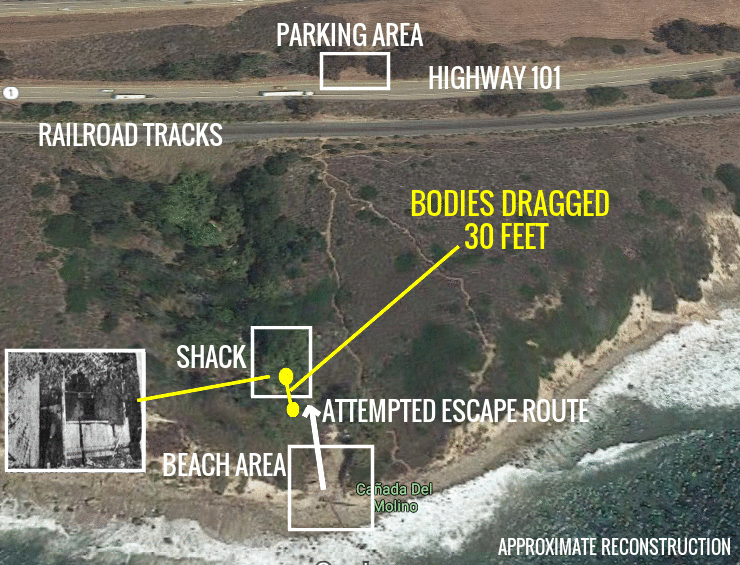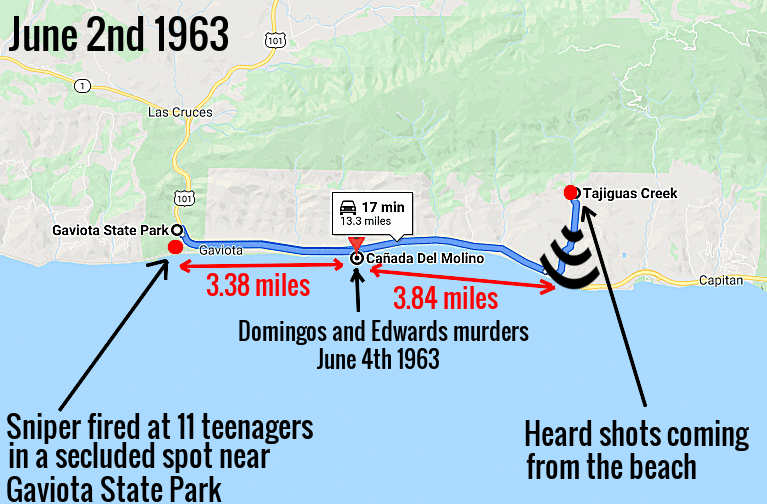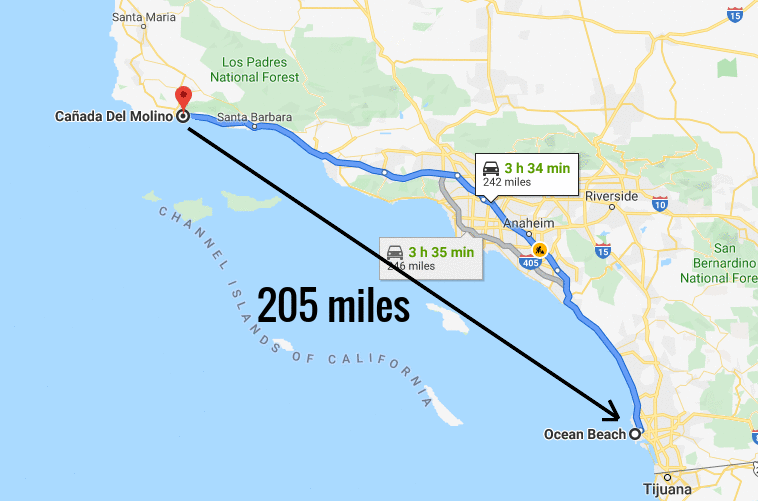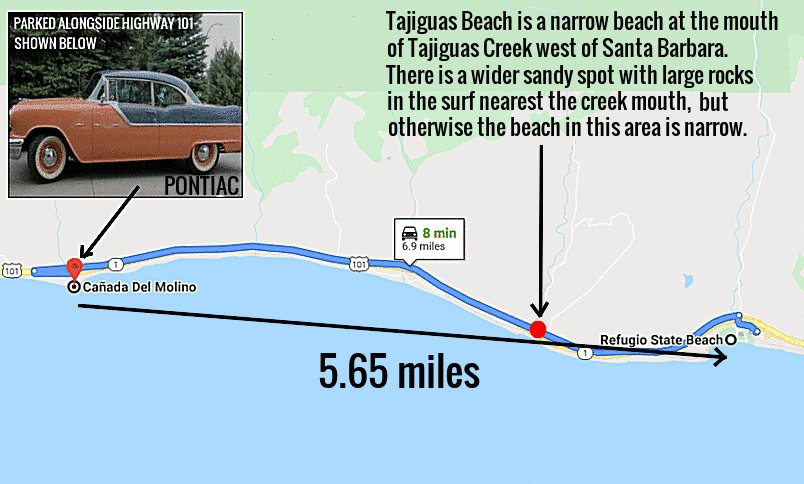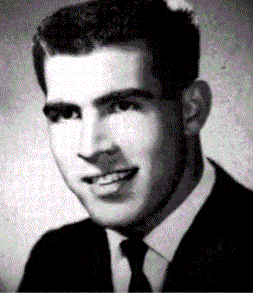 Robert Domingos
Robert Domingos It is now 56 years since the brutal slaying of Robert George Domingos (18) and Linda Faye Edwards (17) at Canada Del Molino on June 4th 1963. The area was 25 miles west of Santa Barbara. The young couple had driven to the beach in their copper and black 1956 Pontiac, parking alongside Highway 101, before taking the 6 to 10 minute descent to the water's edge. It was believed they arrived at the beach at about 3:00 pm. Sometime after they arrived they were approached by one or more people, by whom they were thought to have been forced under gunpoint to be restrained using pre-cut lengths of rope. However, there may have been resistance from Robert Domingos and possibly a brief exchange of blows, before the couple fled for their lives. Their bid for freedom was short-lived, having been gunned down by 19 bullets from a .22 caliber weapon. Robert Domingos was shot eleven times and Linda Edwards was struck eight times, in which the killer reloaded at least once. Robert was dragged face down 30 feet to a nearby shack, while Linda was dragged face up and her body placed atop of Robert. Her bathing suit was found cut open exposing her breasts, but there appeared to be no sexual interaction. Several boxes of .22 ammunition was found inside the shack, along with spent matches.
There have been the obvious parallels drawn to the Lake Berryessa attack on September 27th 1969, but despite the reports of pre-cut lengths of rope, there appears little else to connect this crime to the knife attack on Cecelia Shepard and Bryan Hartnell, other than a waterfront scene (although detectives may have information unavailable to the public). However, there is much more reason to connect the murder of Robert Domingos and Linda Edwards to the recent sniper reports only two days prior to this attack, on June 2nd 1963.
There have been the obvious parallels drawn to the Lake Berryessa attack on September 27th 1969, but despite the reports of pre-cut lengths of rope, there appears little else to connect this crime to the knife attack on Cecelia Shepard and Bryan Hartnell, other than a waterfront scene (although detectives may have information unavailable to the public). However, there is much more reason to connect the murder of Robert Domingos and Linda Edwards to the recent sniper reports only two days prior to this attack, on June 2nd 1963.
 Linda Edwards
Linda Edwards There were at least two reports of gunfire either side of the area where Robert and Linda were eventually murdered. Eleven teenagers in total reported two bullets whizzing past them as they were standing by their vehicles in a remote area of Gaviota State Park. They had been surfing at the beach that day. They reported that the shooting took place at around mid-afternoon. In another incident seven miles east, three teenagers camping at Tajiguas Creek reported hearing gunshots coming from the beach, just south of their location. The time was given as daybreak. Both sets of earwitnesses descrbed what they thought was the sound of a .22 gun.
There are obvious similarities in these events to the Domingos and Edwards story, in that the ammunition used in their murders was .22 caliber. They too were teenagers hanging out close to the coastline - and two of the attacks were believed to have occurred in mid-afternoon (about 3:00 pm in the case of Domingos and Edwards). The sniper attack at Gaviota State Park occurred 3.38 miles west of Canada Del Molino, and the teenagers at Tajiguas Creek heard gunshots coming from the beach approximately 3.84 miles east of Canada Del Molino. Then, two days later Robert and Linda were killed in an area bisecting these two points. What is extremely interesting (if correct) is Sheriff Webster stated that the lot number of the ammunition used in the murder of Robert and Linda was the same as the lot number of ammunition sold at a Santa Barbara store in April. The lot numbers also matched ammunition sold at Vandenberg Air Force Base, but the boxes at the crime scene were devoid of the price tags usually sold at the Air Base. The ammunition was Western Super X .22 caliber long rifle with a lot number TL-21. A lot number is an identification number assigned to a particular quantity or lot of material from a single manufacturer. Lot numbers can typically be found on the outside of packaging. Western Super X .22 caliber was used by the Zodiac Killer at Lake Herman Road.
There are obvious similarities in these events to the Domingos and Edwards story, in that the ammunition used in their murders was .22 caliber. They too were teenagers hanging out close to the coastline - and two of the attacks were believed to have occurred in mid-afternoon (about 3:00 pm in the case of Domingos and Edwards). The sniper attack at Gaviota State Park occurred 3.38 miles west of Canada Del Molino, and the teenagers at Tajiguas Creek heard gunshots coming from the beach approximately 3.84 miles east of Canada Del Molino. Then, two days later Robert and Linda were killed in an area bisecting these two points. What is extremely interesting (if correct) is Sheriff Webster stated that the lot number of the ammunition used in the murder of Robert and Linda was the same as the lot number of ammunition sold at a Santa Barbara store in April. The lot numbers also matched ammunition sold at Vandenberg Air Force Base, but the boxes at the crime scene were devoid of the price tags usually sold at the Air Base. The ammunition was Western Super X .22 caliber long rifle with a lot number TL-21. A lot number is an identification number assigned to a particular quantity or lot of material from a single manufacturer. Lot numbers can typically be found on the outside of packaging. Western Super X .22 caliber was used by the Zodiac Killer at Lake Herman Road.
Even though there were reports that the murderer of Robert and Linda attempted to burn down the shack where he placed the bodies, determining when these matches were struck, along with the tarpaulin scorch marks noted, is impossible to correlate with the murders. But why would the murderer or murderers waste valuable time dragging two bodies over difficult terrain, at least 60 feet in total? Why not just exit the area as soon as possible and immediately separate yourself from the crime scene? The stacking of the bodies one on top of the other must have been done for purpose. Likely a male killer, it is probably no surprise that Linda was discovered on top of Robert with her breasts exposed. Unless her bathing costume had been torn during the dragging of the bodies, then it's extremely likely there was a sexual component to this crime. The killer may have wanted to spend time with the bodies in the seclusion of the shack. The hunter bringing home the prey to satisfy his necrophilic tendencies (a fascination with dead bodies). There seems little other purpose to relocate the bodies in such a fashion. If the killer had worn gloves and shot the couple at distance, there appears no barrier stopping the person just leaving the scene.
It is highly unlikely that a killer would carry boxes of ammunition to a crime scene to perpetrate one or two murders. A clip or two is more than enough. If this person was a hunter who enjoyed taking pot-shots at wildlife (including birds), a day by the ocean in relative seclusion would be the ideal day out - and somebody arriving at the shack with several boxes of ammunition could certainly keep themselves entertained for a long period of time. If this hunter of animals had an over zealous intersest in killing (or was maybe the sniper taking pot-shots at teenagers), then when Robert and Linda inadvertently walked into his lair, their fate was effectively sealed. This time he could get close up and personal. His eventual slaying of the couple was certainly overkill by any standards - suggesting he enjoyed the act of killing - and his enjoyment continued with his interaction with the bodies far longer than the crime scene necessitated. The notion of a killer attempting to burn down the shack to destroy evidence makes little sense. It would have actually drawn attention to the area and any vehicle he may have parked nearby. However, separating yourself from the boxes of ammunition makes far more sense. It is also extremely likely the killer was familiar with this area - off the beaten track, away from prying eyes and ideal for a spot of shooting practice, inanimate or otherwise.
It is highly unlikely that a killer would carry boxes of ammunition to a crime scene to perpetrate one or two murders. A clip or two is more than enough. If this person was a hunter who enjoyed taking pot-shots at wildlife (including birds), a day by the ocean in relative seclusion would be the ideal day out - and somebody arriving at the shack with several boxes of ammunition could certainly keep themselves entertained for a long period of time. If this hunter of animals had an over zealous intersest in killing (or was maybe the sniper taking pot-shots at teenagers), then when Robert and Linda inadvertently walked into his lair, their fate was effectively sealed. This time he could get close up and personal. His eventual slaying of the couple was certainly overkill by any standards - suggesting he enjoyed the act of killing - and his enjoyment continued with his interaction with the bodies far longer than the crime scene necessitated. The notion of a killer attempting to burn down the shack to destroy evidence makes little sense. It would have actually drawn attention to the area and any vehicle he may have parked nearby. However, separating yourself from the boxes of ammunition makes far more sense. It is also extremely likely the killer was familiar with this area - off the beaten track, away from prying eyes and ideal for a spot of shooting practice, inanimate or otherwise.
These beach side locations were the perfect spot for somebody wanting a degree of privacy and cover, while shooting at unsuspecting beachgoers, as was the case with the surfers at Gaviota State Park. An area such as the one shown here provides ample cover as well as an exposed target. The same can be seen at the beach area by Tajiguas Creek. It is difficult to say with any certainty that a sniper was operating at Gaviota State Park and Tajiguas Creek, however, these two reports so close to the murders of Robert and Linda are extremely pertinent with respect to their untimely deaths. As with serial killers, the employment of a buffer zone from residence to crime scene can be resourced as a valuable tool in narrowing down the offender's home location, so somebody traveling from Goleta or Santa Barbara would be leaving a buffer zone of 18 and 25 miles respectively to Canada Del Molino.
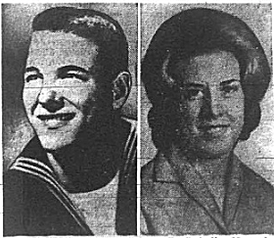
205 miles southeast of Canada Del Molino and eight months later, John and Joyce Swindle, a newlywed couple were brutally gunned down on Wednesday February 5th 1964 as they were enjoying an evening out on Ocean Beach, San Diego, near Narragansett Avenue. It appeared the killer had shot them from distance first, perched near a retaining wall overlooking the sea, before moving in to deliver the final shots at close range. Five shots from a .22 caliber weapon had been discharged from his sniper position by the rocks, with the last two as he approached the felled couple. "On the ledge of the retaining wall police found a box of Valentine candy. Police assume the Swindles bought the candy while on their stroll but they said it could have been left behind as a deranged killer's calling card".
Early on in the investigation of the Domingos and Edwards murders, a 17-year-old boy from Lompoc was arrested due to intoxication and revealed to investigators that he knew the murdered couple, having been jealous of Robert Domingos - and it was noted by investigators that the boy had a badly bruised hand and knuckles "pushed in", consistent with a fight. It was believed that Robert Domingos may have struggled with the assailant before being shot. He explained to officers he had been at Refugio Beach on the Tuesday of their murder and Refugio Beach is 5.65 miles east of the crime scene. Under questioning the teenager was combative and belligerent, indicative of somebody who was already known to Lompoc police, having a previous arrest record.
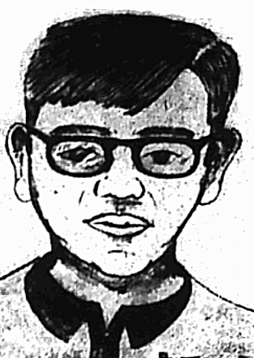 Sketch of "Sandy".
Sketch of "Sandy". On June 5th 1963, investigators traveled to Santa Cruz to apprehend two teenagers, James L. Coleman and J, C, Reed for the fatal stabbing of Vernon Charles Smith (63) in Lompoc during a robbery. They claimed their vehicle had ran out of gas and asked Vernon Smith for his assistance. Neither were considered suspects in the Domingos and Edwards slayings, but implicated a third person called "Sandy" in the murder of Vernon Smith. The two youths admitted their part in the robbery, but claimed it was "Sandy" who perpetrated the murder of Vernon Smith at San Miguelito Canyon, approximately 3 miles south of Lompoc. He was discovered lying on his back in a gravel ditch, towards the front side of his green 1951 Willy's Jeep pick-up. Close by was the gasoline can and fuel that he had acquired at a nearby gas station to help the teenagers. His cause of death was a knife wound to the back which penetrated his heart. Coleman and Reed were eventually convicted in a Santa Barbara County court and sentenced to 5 years to life for second-degree murder. "Sandy" was then sought for questioning in relation to the Domingos and Edwards murders. Santa Barbara detectives later stated that they discovered a vehicle stolen by the three youths and inside retrieved some clothing thought to have been owned by "Sandy". The clothing contained the names "Robert Coffman" and "William Carr", one of which they believe could be the true identity of "Sandy".
"Mabel Keener, manager of the Royal Motel, Arroye Grande, testified a boy resembling "Sandy" came to her hotel at 4 a.m, June 3 and registered as William Carr, of Bakersfield. He stayed until the next morning and left, she said. She declared the sheriff's composite drawing of "Sandy" as made by Hal C. Clark, resembled "Sandy" in some ways but not exactly about the mouth and hair. Raymond W. Kissian and Gilberto Serros, Lompoc gas station attendants, also testified. Serros said he waited on Smith (Vernon) that night when Smith drove up in his jeep, which also contained a youth resembling "Sandy". Smith, who was playing the part of "Good Samaritan" filling up a gas can to take to the youths stalled car in Miguelito Canyon, drove off with a full can of gas, said Serros".
"Mabel Keener, manager of the Royal Motel, Arroye Grande, testified a boy resembling "Sandy" came to her hotel at 4 a.m, June 3 and registered as William Carr, of Bakersfield. He stayed until the next morning and left, she said. She declared the sheriff's composite drawing of "Sandy" as made by Hal C. Clark, resembled "Sandy" in some ways but not exactly about the mouth and hair. Raymond W. Kissian and Gilberto Serros, Lompoc gas station attendants, also testified. Serros said he waited on Smith (Vernon) that night when Smith drove up in his jeep, which also contained a youth resembling "Sandy". Smith, who was playing the part of "Good Samaritan" filling up a gas can to take to the youths stalled car in Miguelito Canyon, drove off with a full can of gas, said Serros".
